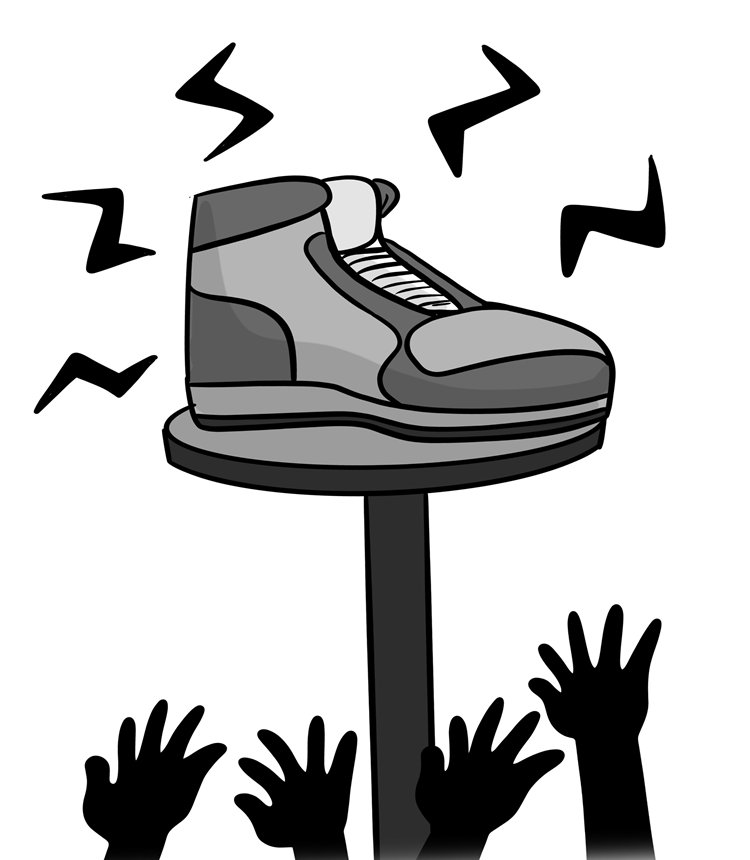HOME >> BUSINESS
Chinese footwear companies should focus on market trends
By Wan Zhe Source:Global Times Published: 2019/9/2 19:31:34
Sneaker speculation teaches traditional footwear companies to focus on market trends

Illustration: Luo Xuan/GT
Chinese shoe brand Fuguiniao was de-listed from the Hong Kong Stock Exchange in August.
A draft of the company's reorganization plan was rejected by the court, its reorganization was terminated and the company has been declared bankrupt.
Fuguiniao had its moment. The shoe brand was established in 1991 and received many awards between 1998 and 2012. When it first listed in Hong Kong in 2013, Fuguiniao's stock was initially trading at HK$8.90 ($1.13). The company owner ranked 148th on the Hurun China Rich List of 2007, tying with a few others including the founder of Alibaba, Jack Ma Yun, and the Wanda Chairman, Wang Jianlin.
Fuguiniao's revenue and net income reached its peak in 2013, and then began to rapidly slow down. In 2016, it was forced to suspend trading on the stock exchange with debt burden weights on the company.
Symptoms of the end of the fashion industry business cycle became evident around 2015, and surging online sales generated by e-commerce development further squeezed offline sales.
In 2017, footwear company Belle International went into privatization, withdrawing its listing from the Hong Kong stock exchange. The company, valued at HK$53.10 billion, shrank almost a third from its peak.
Daphne, a Taiwan-based shoe company which previously occupied nearly 20 percent of the mainland market, has suffered from losses for four consecutive years.
Zhejiang-based Aokang, primarily a men's shoemaker, has been experiencing decreased net profit in recent years.
According to data from the China Leather Industry Association, the production of leather shoes in China waned from 2013 to 2017; production dropped from 4.93 billion pairs per year to 4.48 billion.
Despite these cases, it is not appropriate to say that the sun is setting on the footwear industry. Shoes have become a new target of speculation.
A SoleFly and Air Jordan 1 collaboration sneaker was once priced at 28,599 yuan ($3,996) per pair, despite a recommended retail price of only 1,399 yuan. The shoe-collection market has been thriving in recent years, with many fanatic collectors going to great lengths to acquire the most sought-after products.
Some new shoes are released through an online lottery, while others are released in stores to hundreds of potential customers who have waited in line through the night. The "Ultimate Sneaker Collection Auction," which was held in July, saw 99 out of 100 sneakers from a rare collection sell for $850,000.
But in the wake of such successes in the shoe industry, how is it that other shoe companies can be suffering?
One major reason for Fuguiniao's failure was the company's eagerness to expand into the financial sector - the company launched several investment subsidiaries, including a mining company, a P2P lending firm and even a loans company.
The major challenge that shoe companies and other fashion retailers have faced is not the impact of the internet, but the impact of younger generations. The conflicts between online and offline sales, and between formal shoes and sports shoes are problems that have arisen with the arrival of younger customers.
Many luxurious brands have catered to youngsters' needs, which have put pressure on middle-range brands. The fast-moving consumer goods industry, after two years of rapid development, has been struggling to keep up with the changing needs of consumers. Not to mention brands like Fuguiniao, which have been outdated in their design, marketing and channels.
Brands that understand today's youth will take the market. It's a company, not the market, that runs out of potential.
Indeed, young people are the future, but there are also concerns when they have more purchasing power.
China's high-speed economic growth has provided customers with a broader market space. As living standards rise, consumption demand increases accordingly, as do consumption upgrades.
But it seems that Chinese consumption development has expanded beyond expectations based on economy size, GDP per capita and individual disposable income. Roughly 70 percent of Chinese millennials own a house - twice as many as the US. Chinese consumers of luxury goods are 10 years younger than those in developed countries.
The situation in China today is similar to Japan's in the 1980s, when it was at its peak. Amazing economic growth, high asset prices and high property prices aroused a fever for luxurious brands. However, Japan later entered a period of low expenditure.
If Fuguiniao were to be compared with Air Jordan, many would laugh and say there is no comparison. No matter with what kind of glorious history, any brand that fails to follow the market will perish.
The current situation in the shoe industry is related to an asset bubble in the economy. In an economy with asset bubbles, even young people's purchasing power can be boosted.
After a bubble breaks, people will be able to tell what is worth their investment. But companies have to make sure they won't fall beyond market trends.
The author is chief economist with the International Cooperation Center of China's National Development and Reform Commission and research fellow with the Chongyang Institute for Financial Studies at Renmin University of China. bizopinion@globaltimes.com.cn
Newspaper headline: Sneaker speculation teaches traditional footwear companies to focus on market trends
Posted in: EXPERT ASSESSMENT